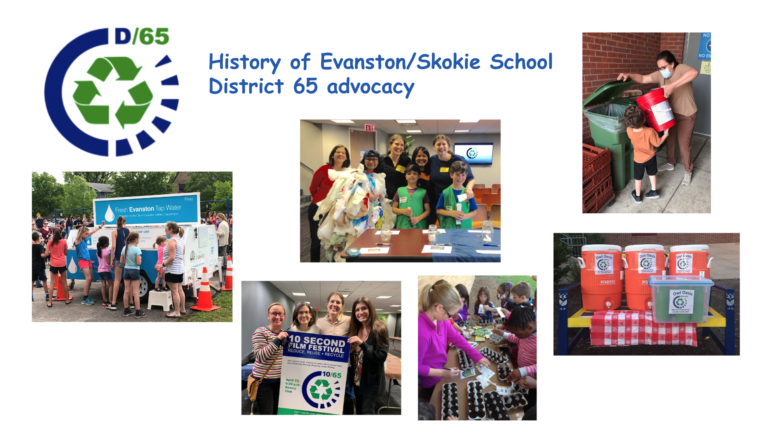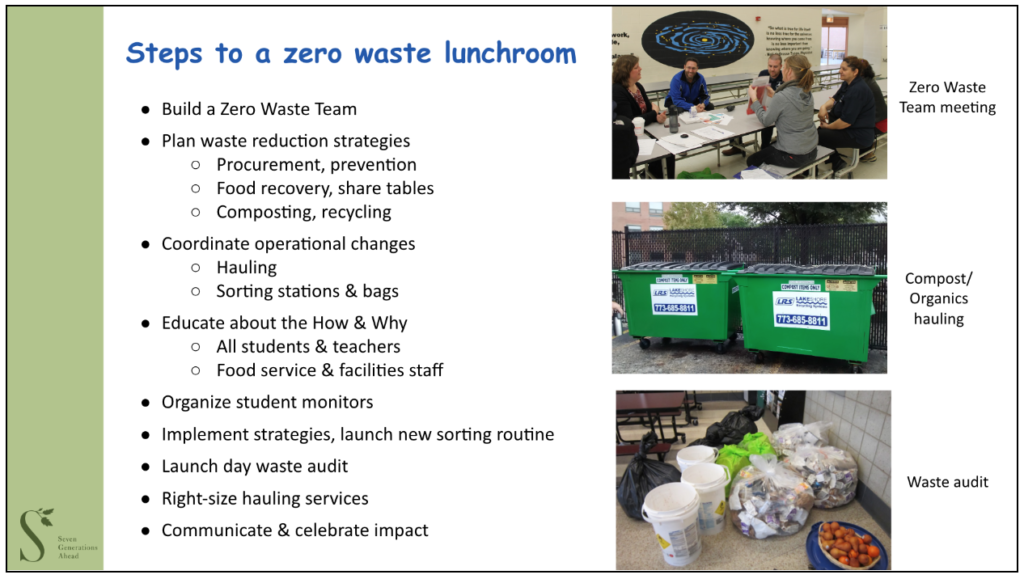
The latest Go Green Illinois meeting was on all things green schools, and SGA’s Becky Brodsky was there to talk zero waste schools with dozens of attendees from 25 communities around Illinois, as well as a fantastic lineup of other speakers. Presenters covered a wide variety of ways schools can become more sustainable, from waste reduction and hiring sustainability coordinators, to transitioning to electric buses and installing onsite solar.
Phoebe Beierle from the Center for Green Schools kicked off the webinar with a look at their efforts to create greener schools. The Center supports and trains people in school systems to implement sustainability initiatives and become change agents, with a focus specifically on school staff. They host the Green Schools Conference (Feb. 27th – March 1st this year) and run the School Sustainability Leaders Network, which has over 150 districts represented across the country, and more than 300 participants. That said, according to Beierle, sustainability roles in K-12 schools are still not very common.
“Pretty much every college campus across the country has an office of sustainability with multiple staff, typically. K-12 is a little bit lagging in this respect for various reasons,” she said. “And our goal really is to help schools understand their role in addressing climate change issues.”
To this end, the Center has conducted research on the drivers for school sustainability positions and the most effective strategies to create them. Top drivers include having administrative or board champions and staff or faculty champions. Notably, student advocacy is significantly growing as a driver, and Beierle expects that trend to continue. The Center’s research also shows that the most effective strategies to create sustainability positions include:
– Create a policy that establishes the creation of a position
– Start with interns or volunteers to make the case for the need and opportunity
– Fundraising to finance the position
– Participating in grant and award opportunities
SGA’s Becky Brodsky shared similar insights from her own experience advocating for sustainability in Evanston/Skokie School District 65. Her work to help make the school district greener began about 15 years ago. Fast forward to 2021, years of hard work had yielded results, but Brodsky and other parent advocates wanted to ensure the momentum would continue.
“We really decided to narrow our focus to advocating for a district sustainability coordinator so that all of the efforts would be longer lasting, institutionalized, and just part of the district culture,” she said. “And also, so things would be more equitable, so all schools would be able to receive the same benefits, even if they didn’t have a dedicated team of parent volunteers.”
The decision to focus their efforts paid off and the district hired a sustainability coordinator last spring. Brodsky said the path to get there included developing strong relationships with the Director of Operations and Coordinator of Nutrition Services, as well as extensive meetings and advocacy with administrators in the school district, as well as with city officials.
 Brodsky’s role as Zero Waste Schools Program Manager for SGA is directly connected to her work within District 65. She helps other schools and school districts on their own path to zero waste by providing resources, workshops, education and waste audits through the Zero Waste Schools program. “We’ve helped dozens of schools across the region divert their waste from the landfill at an average of 85%, including schools in Chicago Public Schools, Cook, Lake and McHenry Counties,” she said.
Brodsky’s role as Zero Waste Schools Program Manager for SGA is directly connected to her work within District 65. She helps other schools and school districts on their own path to zero waste by providing resources, workshops, education and waste audits through the Zero Waste Schools program. “We’ve helped dozens of schools across the region divert their waste from the landfill at an average of 85%, including schools in Chicago Public Schools, Cook, Lake and McHenry Counties,” she said.
Another zero waste schools advocate who spoke at the webinar was Theresa Greinig, Education Coordinator for the Solid Waste Agency of Northern Cook County (SWANCC). According to Greinig, up to 75% of school waste is either recyclable or compostable, meaning there’s plenty of waste that can be diverted from the landfill. But the best approach is to avoid creating the waste in the first place.
“Recycling seems to always get the press, all the discussion. While reduce and reuse are often ignored,” she said. “And that is actually kind of a problem, and that’s where SWANCC comes in. Because the most effective means of sustainable materials management is to reduce and reuse. Only then comes recycling and compost.”
Brodsky and Greinig both pointed out that even small steps in waste reduction can have a big impact. Schools can start out by just focusing on waste reduction in classrooms, the lunchroom, or at events, and then grow from there.
“We need to recognize that zero waste is not a finish line. It’s just a continual process,” said Greinig.
In fact, this is true of all school sustainability efforts, and there are so many ways to get started. From waste reduction and sustainability coordinators, to electric buses and solar panels, it’s clear from Go Green Illinois’ webinar that schools can be tremendous drivers of change and impactful leaders in the fight for a livable climate.
